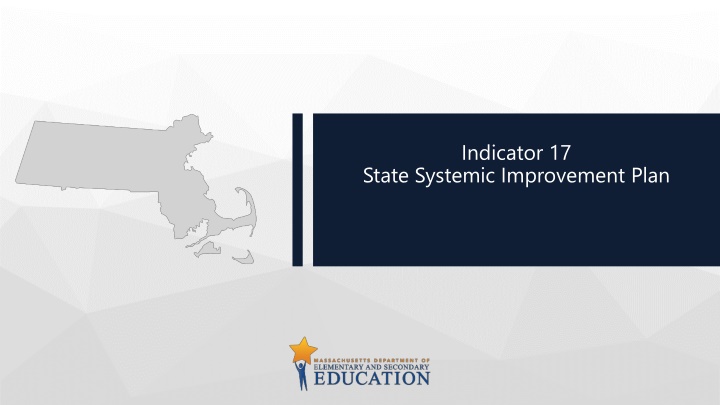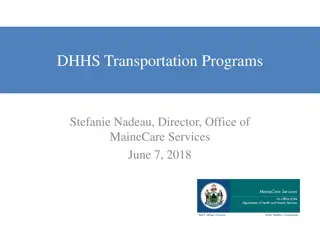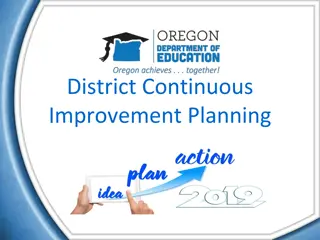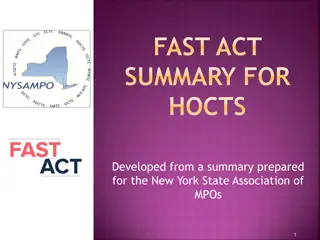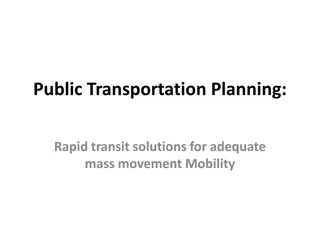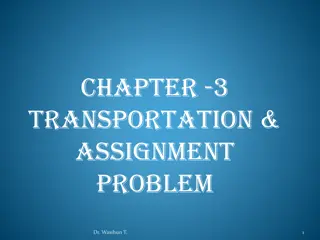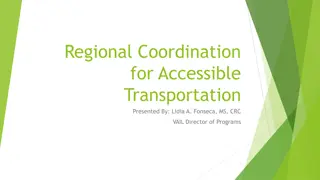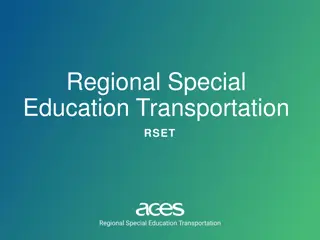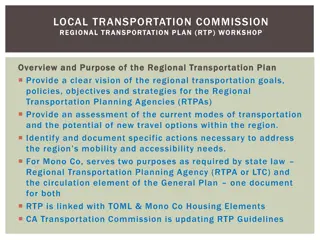Introduction to Master Planning Transportation Improvement Districts
This content delves into the concept of Transportation Improvement Districts (TID) and how they intersect with master planning. It explains the purpose, benefits, and workings of TIDs, emphasizing their role in linking land use and transportation planning for sustainable growth and development. The text highlights the importance of defined geographic areas, participant boundaries, facilities, and the process of identifying necessary improvements within specified timeframes.
Download Presentation

Please find below an Image/Link to download the presentation.
The content on the website is provided AS IS for your information and personal use only. It may not be sold, licensed, or shared on other websites without obtaining consent from the author.If you encounter any issues during the download, it is possible that the publisher has removed the file from their server.
You are allowed to download the files provided on this website for personal or commercial use, subject to the condition that they are used lawfully. All files are the property of their respective owners.
The content on the website is provided AS IS for your information and personal use only. It may not be sold, licensed, or shared on other websites without obtaining consent from the author.
E N D
Presentation Transcript
Indicator 17 State Systemic Improvement Plan
Indicator 17/State Systemic Improvement Plan (SSIP) Comprehensive multi-year plan focusing on improving outcomes for children with disabilities Part of OSEP s Results-Driven Accountability (RDA) initiative to improve results for children with disabilities Indicator 17 of the State Performance Plan/Annual Performance Report (SPP/APR) 2 Massachusetts Department of Elementary and Secondary Education
Indicator 17/SSIP Phases Phase I oData analysis oInfrastructure analysis oState-identified Measurable Result (SiMR: 7A) oCoherent improvement strategies oTheory of Action Phase II oInfrastructure development oSupports for implementing evidence-based practices (MA: Pyramid Model) oEvaluation Plan Phase III oResults of ongoing evaluation oExtent of progress oRevisions to the SSIP 3 Massachusetts Department of Elementary and Secondary Education
Massachusetts State-identified Measurable Result (SiMR) for Indicator 17/SSIP MA SiMR: Percent of preschool children ages 3-5 with IEPs who demonstrate improved positive social-emotional skills (Indicator 7A): SS1 = Of preschool children who entered the program below age expectations the percent who substantially increased their rate of growth by age 6 or exit from the program. SS2 = The percent of preschool children who were functioning within age expectations by age 6 or exit from the program. MA selected the Pyramid Model as the evidence-based practice for the SSIP 4 Massachusetts Department of Elementary and Secondary Education
SiMR Targets for FFY2020-FFY2025 SiMR (7A) Targets FFY 2020 2021 2022 2023 2024 2025 Summary Statement 1 86.00% 86.00% 86.00% 86.50% 87.00% 88.00% Summary Statement 2 50.00% 50.00% 50.00% 50.25% 50.50% 51.00% 5 Massachusetts Department of Elementary and Secondary Education
SSIP Theory of Action Massachusetts ECSE mission is to promote positive outcomes and success in school for all children with disabilities by ensuring equitable access to individualized services and resources for the children and their families. KEY STATE AND INTERAGENCY INITIATIVES SUPPORTING SOCIAL EMOTIONAL OUTCOMES IF THEN Massachusetts leverages broader statewide initiatives, infrastructure and interagency drivers to scale-up the implementation of evidence-based practices, with a focus on culturally responsive/ trauma- informed care, for early childhood social emotional competence, including the Pyramid Model; KEY STATE AND INTERAGENCY ECSE INITIATIVES ECSE programs will participate in high quality PD, develop leadership teams that examine data (including discipline/ suspension data) with a DEI lens and use data for continuous program improvement, train coaches and mentors, and create culturally responsive evaluation plans in partnership with families; THEN ECSE staff will implement culturally- responsive, evidence-based practices program- wide, engage families using DEI practices, examine and use data with DEI lens, and adjust instruction in order to support social- emotional outcomes of all children; PROGRAM LEVEL ACTIVITIES Birth-to-Grade Three Strategies Partnerships: THEN Transition Forums and MOUs THEN ALL SWD will enter the K-12 system with social/ emotional competencies that will allow them to access and participate in the general curriculum and in all aspects of the school. Seamless Integration of DEI and PBS PD CLASSROOM LEVEL ACTIVITIES Evidence-based, universally designed social emotional supports will be culturally responsive and implemented with fidelity. State Leadership Team to support statewide implementation of PBS strategies and the Pyramid Model Partnership with FCSN Program wide PBS PD for all personnel Promoting Positive Social/Emotional Outcomes Grants and Communities of Practice PBS Instruction and Curriculum IMPROVED EARLY CHILDHOOD SOCIAL EMOTIONAL OUTCOMES FOR ALL SWD PBS Coaching and Mentoring for program staff EC Social Emotional Standards and Approaches to Learning Culturally-Responsive PBS Work with Families ESE led: Program-wide family engagement and support Comprehensive System of Personnel Development (CSPD) PBS Data Collection and Analysis through DEI Lens Evidence-Based Practices for Early Childhood Social Emotional Competence Early Childhood Special Education Leadership Institute Program-wide use of data inquiry cycles DESE s Focus on DEI Practices Massachusetts Tiered System of Support Home-School Partnership Initiative MA Discipline Bill Bullying Prevention and Intervention Plans Family Engagement 6 Massachusetts Department of Elementary and Secondary Education
SSIP Evaluation Questions: State Level 1a: In what ways is MA DESE using the SSIP to build state-level capacity to support improved social and emotional outcomes for young children with disabilities? 1b: To what extent is implementation of EC-PBS through Pyramid strategies in MA integrated with other early childhood and/or MA DESE initiatives at the community/local and state levels? 1c: To what extent is MA DESE making the intended improvements to the workforce development structure? 1d. In what ways is MA DESE providing guidance on the integration of DEI principles across early childhood special education initiatives and programs? 7 Massachusetts Department of Elementary and Secondary Education
SSIP Evaluation Questions: District Level 2a: Is the state-level plan resulting in the number of districts, schools, and classrooms participating in PBS through Pyramid strategies growing over time? 2b: To what extent are districts developing systems to support and sustain program-wide EC-PBS through Pyramid strategies? Are districts advancing toward Pyramid Model implementation that is sustainable without active external coach support? 2c. To what extent are districts collecting early childhood discipline/suspension data? How are districts early childhood discipline/suspension data? 2d. In what ways are districts using early childhood discipline/suspension data to inform program improvement and support for staff? 8 Massachusetts Department of Elementary and Secondary Education
SSIP Evaluation Questions: Classroom Level 3a: To what extent are teachers implementing EC-PBS through Pyramid strategies in their classrooms? 3b: Does the fidelity of classroom implementation improve over time? 3c. In what ways are teachers in Pyramid Model classrooms using culturally sustaining practices when supporting the social and emotional development of preschool children with IEPs? 9 Massachusetts Department of Elementary and Secondary Education
SSIP Evaluation Questions: Student Level 4b: Is the percentage of children in MA with disabilities who exit from early childhood special education services with age-expected social and emotional functioning increasing? o Does being served by an SSIP district increase the likelihood that children in MA with disabilities will exit from preschool special education services with age-expected social and emotional functioning in comparison to their peers in non-SSIP districts? o Does being served in a Pyramid classroom increase the likelihood that children in MA with disabilities will exit from preschool special education services with age-expected social emotional functioning in comparison to their peers in non-Pyramid districts? 4c: Is the percentage of children in MA with disabilities who exit from early childhood special education with greater than expected growth in social and emotional functioning increasing? o Do changes differ by SSIP district status? 4d: How do improvements in children s social emotional functioning compare across subgroups? 10 Massachusetts Department of Elementary and Secondary Education
Additional Resources National Center for Pyramid Model Innovations: National Center for Pyramid Model Innovations (challengingbehavior.org) Pyramid Model Consortium: The Pyramid Model Consortium - Supporting Early Childhood PBIS State Systemic Improvement Plan (SSIP): ECTA Center: State Systemic Improvement Plan (SSIP) 11 Massachusetts Department of Elementary and Secondary Education
